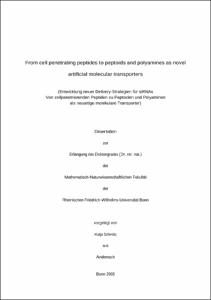Schmitz, Katja: From cell penetrating peptides to peptoids and polyamines as novel artificial molecular transporters : Entwicklung neuer Delivery-Strategien für siRNAs ; Von zellpenetrierenden Peptiden zu Peptoiden und Polyaminen als neuartige molekulare Transporter. - Bonn, 2005. - Dissertation, Rheinische Friedrich-Wilhelms-Universität Bonn.
Online-Ausgabe in bonndoc: https://nbn-resolving.org/urn:nbn:de:hbz:5N-05317
Online-Ausgabe in bonndoc: https://nbn-resolving.org/urn:nbn:de:hbz:5N-05317
@phdthesis{handle:20.500.11811/2273,
urn: https://nbn-resolving.org/urn:nbn:de:hbz:5N-05317,
author = {{Katja Schmitz}},
title = {From cell penetrating peptides to peptoids and polyamines as novel artificial molecular transporters : Entwicklung neuer Delivery-Strategien für siRNAs ; Von zellpenetrierenden Peptiden zu Peptoiden und Polyaminen als neuartige molekulare Transporter},
school = {Rheinische Friedrich-Wilhelms-Universität Bonn},
year = 2005,
note = {In recent years, RNA interference has gained a lot of importance as a tool for posttranscriptional silencing of genes due to its high specificity, efficiency and ease of application. In mammalian cells RNAi is triggered by the application of 21 bp short dsRNAs, so-called short interfering RNAs (siRNAs). Numerous studies indicate the great potential of RNAi in the therapy of viral infections and inherited diseases.
Cell-penetrating peptides can be used to apply siRNAs to primary cells, non-dividing cells or fully grown organisms, that are diffcult to transfect.
These short positively charged peptides are internalized by cells. They can be detected in the endosomes, lysosomes but also in the cytosol. If attached to CPPs, large cargo molecules can be taken up with a high efficiency that surpasses that of most conventional transfection methods.
In the work presented here, peptide-coupled siRNAs (pepsiRNAs) have been developed as a novel tool for transient RNAi in mammalian cells. The peptides were attached to the siRNA by a disulfide bond, that is cleaved under the reducing conditions of the cytosol and thus releases the siRNA cargo. PepsiRNAs are readily taken up by many cell types that are difficult to address by conventional transfection methods. An siRNA-induced downregulation of the targeted genes was observed at concentrations between 10 and 100 nM.
SiRNAs with a 5´-thiol modification upon their sense-strand were generated by in vitro transcription, for which a thiol-modified nucleotide was synthesized via an optimized route.
The cell-penetrating peptides Penetratin and Tat were recombinantly expressed as fusion-proteins with glutathione-S-transferase (GST) and purified with a modified procedure to overcome the strong membrane interaction of the GST-tagged CPPs. Recombinant TEV protease was expressed to cleave the CPPs from the fusion tag, and the cleavage activity was assessed by comparison with commercially obtained TEV protease. Thus, alternative routes to the building blocks for pepsiRNAs have been provided to scale up the amount of pepsiRNAs.
Finally, small molecules with cell-penetrating properties have been developed as a future replacement of the peptide moiety. Fluorescently labeled peptoids of differing length with amine-functionalized side chains have been shown to enter different mammalian cells lines at concentrations in the lower micromolar range by an endocytosis dependent mechanism. Cationic molecules as small as spermine attached to fluorescein are taken up by an endocytosis-related mechanism. By the same approach porphyrins were delivered into the interior of the cells, where they exhibited a cytotoxic effect upon illumination, so that spermine-coupled porphyrins may be developed into a novel drug for photodynamic therapy.},
url = {https://hdl.handle.net/20.500.11811/2273}
}
urn: https://nbn-resolving.org/urn:nbn:de:hbz:5N-05317,
author = {{Katja Schmitz}},
title = {From cell penetrating peptides to peptoids and polyamines as novel artificial molecular transporters : Entwicklung neuer Delivery-Strategien für siRNAs ; Von zellpenetrierenden Peptiden zu Peptoiden und Polyaminen als neuartige molekulare Transporter},
school = {Rheinische Friedrich-Wilhelms-Universität Bonn},
year = 2005,
note = {In recent years, RNA interference has gained a lot of importance as a tool for posttranscriptional silencing of genes due to its high specificity, efficiency and ease of application. In mammalian cells RNAi is triggered by the application of 21 bp short dsRNAs, so-called short interfering RNAs (siRNAs). Numerous studies indicate the great potential of RNAi in the therapy of viral infections and inherited diseases.
Cell-penetrating peptides can be used to apply siRNAs to primary cells, non-dividing cells or fully grown organisms, that are diffcult to transfect.
These short positively charged peptides are internalized by cells. They can be detected in the endosomes, lysosomes but also in the cytosol. If attached to CPPs, large cargo molecules can be taken up with a high efficiency that surpasses that of most conventional transfection methods.
In the work presented here, peptide-coupled siRNAs (pepsiRNAs) have been developed as a novel tool for transient RNAi in mammalian cells. The peptides were attached to the siRNA by a disulfide bond, that is cleaved under the reducing conditions of the cytosol and thus releases the siRNA cargo. PepsiRNAs are readily taken up by many cell types that are difficult to address by conventional transfection methods. An siRNA-induced downregulation of the targeted genes was observed at concentrations between 10 and 100 nM.
SiRNAs with a 5´-thiol modification upon their sense-strand were generated by in vitro transcription, for which a thiol-modified nucleotide was synthesized via an optimized route.
The cell-penetrating peptides Penetratin and Tat were recombinantly expressed as fusion-proteins with glutathione-S-transferase (GST) and purified with a modified procedure to overcome the strong membrane interaction of the GST-tagged CPPs. Recombinant TEV protease was expressed to cleave the CPPs from the fusion tag, and the cleavage activity was assessed by comparison with commercially obtained TEV protease. Thus, alternative routes to the building blocks for pepsiRNAs have been provided to scale up the amount of pepsiRNAs.
Finally, small molecules with cell-penetrating properties have been developed as a future replacement of the peptide moiety. Fluorescently labeled peptoids of differing length with amine-functionalized side chains have been shown to enter different mammalian cells lines at concentrations in the lower micromolar range by an endocytosis dependent mechanism. Cationic molecules as small as spermine attached to fluorescein are taken up by an endocytosis-related mechanism. By the same approach porphyrins were delivered into the interior of the cells, where they exhibited a cytotoxic effect upon illumination, so that spermine-coupled porphyrins may be developed into a novel drug for photodynamic therapy.},
url = {https://hdl.handle.net/20.500.11811/2273}
}






